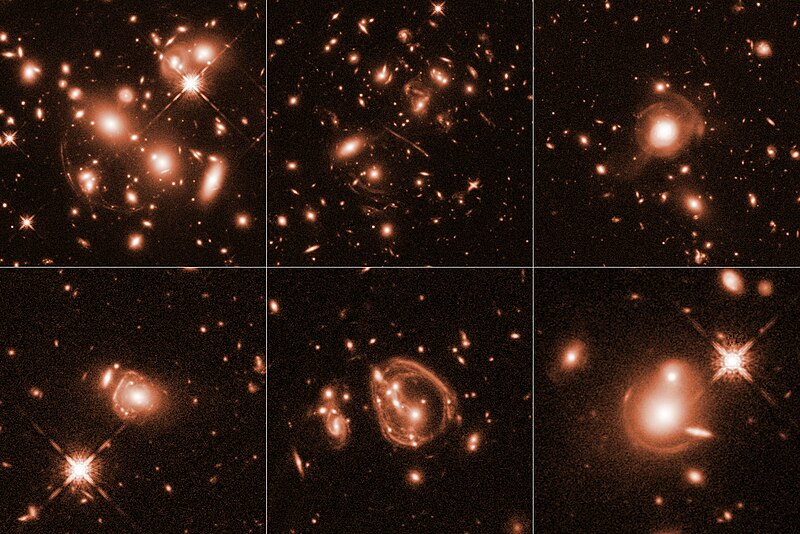File:Hubble captures gallery of ultra-bright galaxies.jpg

Original file (3,190 × 2,128 pixels, file size: 2.27 MB, MIME type: image/jpeg)
Summary
| DescriptionHubble captures gallery of ultra-bright galaxies.jpg | English: These six images, taken by the NASA/ESA Hubble Space Telescope, reveal a jumble of misshapen-looking galaxies punctuated by exotic patterns such as arcs, streaks, and smeared rings. These unusual features are the stretched shapes of the brightest infrared galaxies in the Universe that are boosted by natural cosmic magnifying lenses. This effect, called gravitational lensing, occurs when the intense gravity of a massive galaxy or cluster of galaxies magnifies the light of more distant background sources.
The distant, lensed galaxies are as much as 10 000 times more luminous than our Milky Way. The lensing phenomenon allows for features as small as about 100 light-years or less across to be seen in the background galaxies. The galaxies existed between 8 billion and 11.5 billion years ago, when the Universe was making stars more vigorously than it is today. The galaxies are ablaze with runaway star formation, creating more than 10 000 new stars a year. This star-birth frenzy creates lots of dust, which enshrouds the galaxies, making them too faint to detect in visible light. But they glow fiercely in infrared light, shining with the brilliance of 10 trillion to 100 trillion suns. The infrared galaxies in these images are part of a Hubble survey of 22 distant ultra-luminous infrared galaxies that were found by ground- and space-based observatories. The images were taken in infrared light by Hubble's Wide Field Camera 3. These results are not peer-reviewed and were presented at the 230th meeting of the AAS. |
| Date | |
| Source | https://www.spacetelescope.org/images/opo1724a/ |
| Author | NASA, ESA, and J. Lowenthal (Smith College) |
Licensing
| ESA/Hubble images, videos and web texts are released by the ESA under the Creative Commons Attribution 4.0 International license and may on a non-exclusive basis be reproduced without fee provided they are clearly and visibly credited. Detailed conditions are below; see the ESA copyright statement for full information. For images created by NASA or on the hubblesite.org website, or for ESA/Hubble images on the esahubble.org site before 2009, use the {{PD-Hubble}} tag. Conditions:
Notes:
|
- You are free:
- to share – to copy, distribute and transmit the work
- to remix – to adapt the work
- Under the following conditions:
- attribution – You must give appropriate credit, provide a link to the license, and indicate if changes were made. You may do so in any reasonable manner, but not in any way that suggests the licensor endorses you or your use.
Captions
Items portrayed in this file
depicts
copyright status
copyrighted
copyright license
Creative Commons Attribution 4.0 International
inception
7 June 2017
File history
Click on a date/time to view the file as it appeared at that time.
| Date/Time | Thumbnail | Dimensions | User | Comment | |
|---|---|---|---|---|---|
| current | 14:37, 8 June 2017 |  | 3,190 × 2,128 (2.27 MB) | Jmencisom | User created page with UploadWizard |
File usage
The following page uses this file:
Global file usage
The following other wikis use this file:
- Usage on el.wikipedia.org
- Usage on ig.wikipedia.org
Metadata
This file contains additional information, probably added from the digital camera or scanner used to create or digitize it.
If the file has been modified from its original state, some details may not fully reflect the modified file.
| Image title |
|
|---|---|
| Credit/Provider | NASA, ESA, and J. Lowenthal (Smith College) |
| Source | ESA/Hubble |
| Short title |
|
| Usage terms |
|
| Keywords |
|
| Contact information |
Karl-Schwarzschild-Strasse 2 Garching bei München, , D-85748 Germany |
| IIM version | 4 |


